Norwich Terrier: features of the breed and the secrets of its maintenance
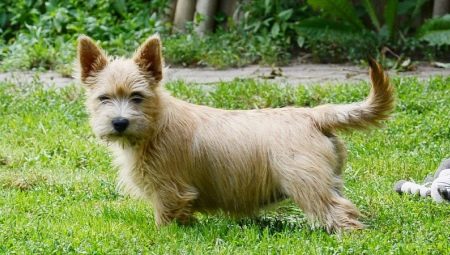
Adorable Norwich Terriers are representatives of the famous English hunting breed. These animals are characterized by a cheerful and positive disposition. They are not only suitable for hunting - Norwich Terriers are also wonderful companions. Today we will take a closer look at these interesting pets and learn how to properly care for them.
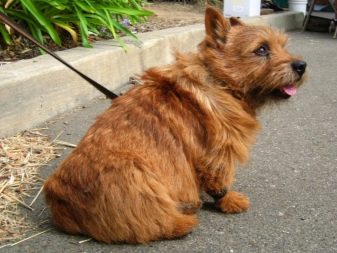
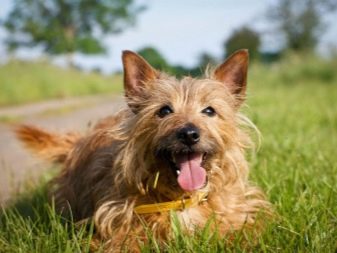
Origin story
Experts believe that representatives of this breed of dogs appeared no later than the 19th century in Norwich (or Norwich), located in the east of England. Initially, these small pets were exploited as a good workforce: they actively participated in hunting for game living in burrows, and also were engaged in the extermination of rats that were found in food stores. Already at that time, the Norwich Terrier was making an excellent companion.
Researchers have never been able to figure out which specific breeds were involved in breeding Norwich Terriers. However, according to popular belief, they are the direct descendants of the Irish Terriers or Trumpington Terriers, which are no longer found in our time.
In 1932, the English Kennel Club recognized the Norwich Terrier breed. At the same time, certain requirements were presented to its representatives. Two main types of dogs were identified. For a long time, the debate about which type is more suitable for exhibitions did not subside. Since the early 1930s, breeders have tried their best to give as much noticeable difference to the different types of these dogs as possible.
In the course of painstaking work, two separate categories of the breed were identified: Norfol and Norwich.
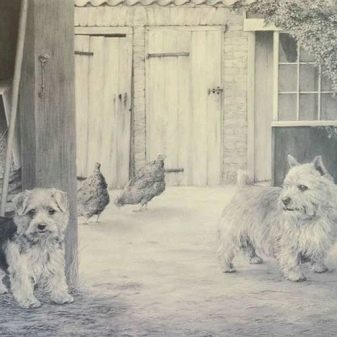
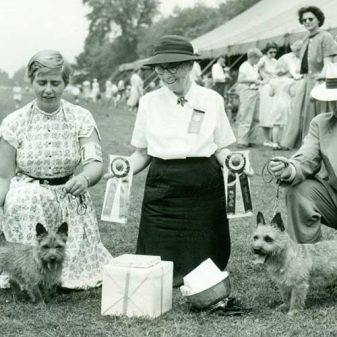
Description of the breed
Norwich Terriers fit the description of ordinary burrowing hunters. They are distinguished by a squat structure. They have a strong skeleton and a chest of medium width.
Among the representatives of this English breed, the smallest individuals can weigh no more than 5.2 kg. The growth of the smallest dogs is usually no more than 26 cm. At exhibitions and competitions, experts do not lower the marks if the four-legged participant has "battle marks" left after the hunt. Usually these are lesions on the ears or skin of the animal. Of course, the marks will not be downgraded if the existing injuries do not affect the usefulness of the animal in any way.
There are recognized standards that indicate all the characteristics inherent in these pets. Let's get acquainted with them in more detail.
- Since the coat of these pets is thick and solid, their head looks more voluminous and larger than it actually is. Like other famous terriers, Norwegians have a spacious skull with a slightly rounded apex. The forehead looks flattened and dramatically "flows" into the bridge of the nose. Closer to the lobe of the nose, the muzzle of these pets becomes more and more narrow.
- The lips of thoroughbred individuals will always be thin and tightly pressed to the jaws. The teeth are large and upright. The canines are firmly closed to form a standard scissor bite.
- The nose of these dogs is miniature in size. It is characterized by noticeable sensitivity and is mobile.
- The eyes of the Norwegians are oval in shape, set at a noticeable depth, which is a protective feature of the structure. The color of the iris is usually close to dark brown. The Norwich Terrier's eyes are always interested and expressive. In their eyes, there are notes of positive and some kind of cute laugh.
- The ears of purebred representatives of the breed are characterized by a triangular structure. They are medium in size and can be exclusively upright - other options are not allowed by the standards. In the course of work, the ears are always noticeably tense and "look" forward. If the dog is completely calm, the ears will be slightly pulled back.
- The body of small hunters is very strong, has a rectangular structure. The neck is firm, but not too long. The scruff is weakly expressed, and the dewlap is completely absent. The chest in thoroughbred Norwegians should not be too wide, as this will seriously interfere with burrowing work.
- The ribs of the Norwich Terriers are springy and strongly pulled back.
- The sternum is slightly lowered to the line where the elbows are, or slightly lower. The shoulders of the animals are well developed. The back is straight and merges smoothly into the croup and loin, which is not too pronounced.
- The limbs of purebred dogs do not differ in great length - they are short, straight, a little thick. The elbows are close to the sternum, the thigh is strong and of moderate length. The forelimbs are more muscular than the hindquarters.
- The paws of the Norwich are large, have well-developed strong claws. The pads are well filled, which makes this hunting breed excellent at digging.
- The tail is flush with the back of the dogs or slightly higher. It can be either intact or docked - both options are allowed. If the tail is not docked, then it should be strong and straight. A slight bend is allowed. If this limb was docked, then it should be extremely straight and represent a continuation of the spine line.
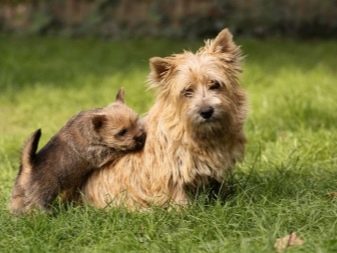
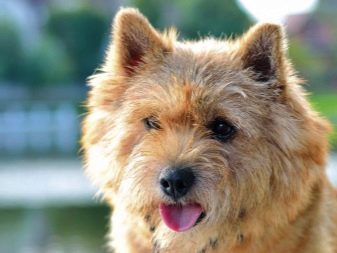
Representatives of many other similar breeds can envy the coat of the Norwich. In small English hunters, wool is distinguished by a high density and a good undercoat layer.On the head, muzzle and ears, the coat is smooth and short. To the touch, it looks more like a delicate and pleasant silk.
The neck and scruff of the Norwich Terrier are decorated with a luxurious collar, which from the side looks like a solid lion's mane. It is collected from a guard hair of considerable length. The Norwich's muzzle has a slight beard and thick, pronounced eyebrows.
The coat color of Norwich can vary markedly. The following colors are allowed by the standards:
- red - monochromatic coat color, can vary from light red to dark red;
- zoned - is a combination of red and black shades of wool (proportions may vary);
- black and tan (dominant shade) - uniform black, there are reddish-brown markings in the region of the limbs, muzzle, abdomen, chest.
In dogs of the described breed, the coat cannot be white. Even small white spots are not allowed by the current standards.
There may be small marks or scars of light colors that the dog has acquired in the process.

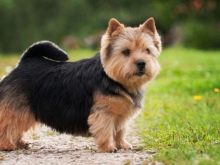
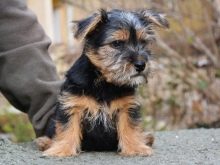
Character
As in the case of other breeds, you can buy a Norwich Terrier puppy only after having familiarized yourself with all the traits of its character.
Norwich are active and highly motivated pets. They are hardy and rarely fool around, although they look funny. A pet of this type is recognized as a wonderful assistant in hunting. In addition, he will make a wonderful friend who will always be positive. Norwich Terriers are very attached to their owners and have an incredibly good-natured disposition. Communication with a person for them is true happiness.
This cute and playful dog can be taken into a family with children without fear. The Norwich will surprisingly quickly find a common language with the younger members of the family and figure out how to have fun together. Such leisure will necessarily be accompanied by incessant fuss, bustle and enthusiastic squeals - you can forget about the silence.
Once in a new home, a thoroughbred English puppy will quickly charm all family members. People fall in love with Norwegians at first sight. These pets do not show zealous behavior, so they can live in the same territory with other pets without any problems.
Such a neighborhood will not strain the dogs of this breed, they will not show their ardent discontent.
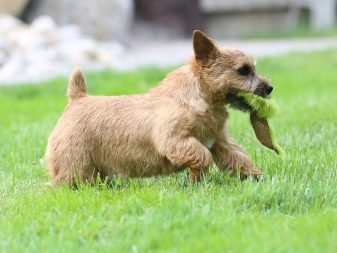
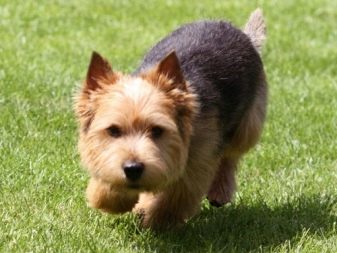
If you wanted to acquire such a cute and funny pet, then you need to know in advance that the Norwegians are not only very active, but also very curious. At times they can be very noisy, bringing real "chaos" into the house. Dogs of this breed do not hesitate to give a voice. The reason for this can be both the dog's joy and his anxious mood. Often the Norwegians put their teeth into business and begin to gnaw absolutely everything that only they liked and aroused interest.
Despite the fact that Norwich Terriers are small dogs and have a naturally perky disposition, they are not devoid of nobility and prefer to demonstrate independence more often. The hunting qualities of these animals are excellent, so it is better not to let them off the leash while walking. Chasing a cat passing by, a Norwich can get so carried away that he stops responding to the owner's commands. As a result, the animal may get lost.
Norwich are very vigilant pets, so they make amazing reliable watchmen. True, from the activities of such a terrier, the local area can noticeably suffer - representatives of this English breed are great fans of digging. During the hunt, they are able to dig even those burrows that are very deep. For this reason, at the house, such dogs will diligently dig the entire area up and down, getting great pleasure from this process.In this case, a lot of the energy of the animal will be spent.
These terriers are distinguished by their high jumping ability. Meeting the owner, such dogs will try to jump on him, showing incredibly joyful emotions.
This behavior is considered bad manners, and it is better to wean the pet from such a habit from puppyhood.
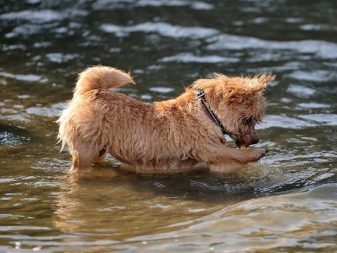
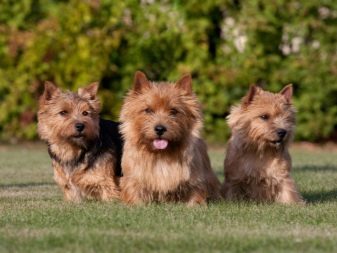
Advantages and disadvantages
Before you go shopping for a purebred Norwich Terrier puppy, you need to weigh the pros and cons of these pets.
First, let's look at what these adorable little hunters are good at.
- Norwich are sociable creatures who enjoy spending time in the company of a person. That is why they make excellent companion dogs.
- These pets are friendly and non-aggressive towards other pets. They also communicate with children without anger and unnecessary caution.
- The level of intelligence of Norwegians is very high. They are quick-witted and quick-witted, quickly master new commands.
- Immunity in Norwegians is considered to be quite strong. They rarely get sick, especially if they are well cared for.
- Norwich Terriers can live without problems in an ordinary city apartment. This is the ideal solution for people who want to have a dog, but do not have much room to keep a large breed.
- These dogs are not jealous, so unnecessary conflicts with pets-neighbors for this reason usually do not arise.
The advantages of dogs of this breed are significant. For them, Norwegians are chosen by many people who want to get hold of such a kind and positive four-legged companion. But Norwich Terriers also have a number of disadvantages that you need to be prepared for.
- The disposition of these dogs is restless. On rare occasions, they may even show aggression.
- Norwich can suddenly throw himself on other people's animals.
- If you want to feed such a dog with ready-made food, you will have to purchase only expensive high-class products. As a result, the maintenance of such a pet can seriously hit the family budget.
- Norwich Terriers should not be let off the leash. You can only walk with him. Otherwise, the pet may start running after the victim of its choice, after which it may no longer be found.
- It is not an easy task to acquire a puppy of this breed on the territory of Russia.
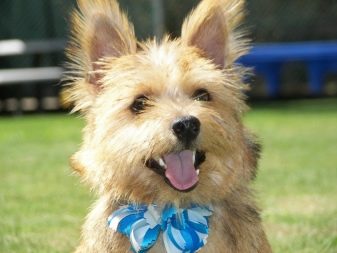
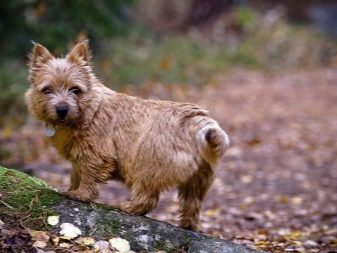
Life span
The Norwich Terrier is a healthy breed with good immunity. Many breeders planning to have such a pet are interested in their life expectancy. Usually these cute "Englishmen" live at least 13-15 years. Much of this also depends on the owners.
If the animal is properly cared for and kept in good conditions, the dog can live longer.
Conditions for maintenance and care
Dogs of this English breed are recognized as universal in matters of care and maintenance. They feel very good and comfortable both in a city apartment and in a private house. For chain or aviary keeping, these good-natured pets are not at all suitable. When the owner is not around, the thoroughbred Norwich will be exposed to serious stress, which will ultimately lead to bad behavior of the animal in general.
Norwich Terriers are active and mobile pets, so they cannot be left without a walk. Walking with such a pet should take at least 2-2.5 hours. Experts strongly advise against walking these pets off a leash.
These dogs need proper grooming. The main problem of Norwegians is thick wool, consisting of two layers. It is important to comb it out thoroughly 2-3 times a week. This should be done in the direction of hair growth. For this purpose, it is recommended to purchase a small wooden comb with long and thin teeth. It is undesirable to use combs and brushes made of plastic, since they will strongly electrify the dog's coat. Removing dead hairs will be much more difficult because of this. During seasonal periods when pets molt, they need competent trimming.
It is advisable to trust the grooming specialists. It is recommended to independently carry out such procedures only if you have experience in this matter. The haircut of thoroughbred hunters must be carried out according to a certain scheme.
It is important to monitor not only the condition of the coat of such a dog, but also the timely implementation of all the necessary hygiene procedures.
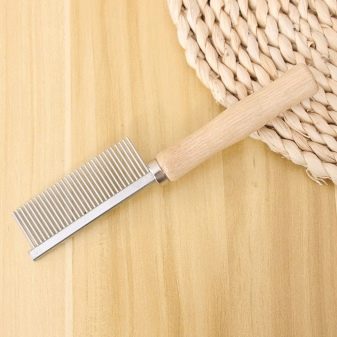
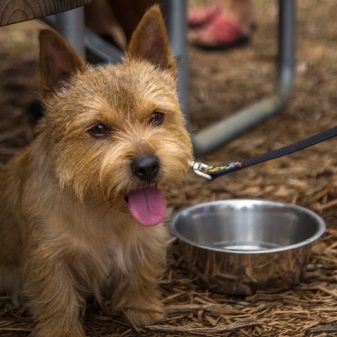
Often bathing Norwich Terriers is strongly discouraged, although it can be difficult for owners of small hunters to adhere to this recommendation: Norwich loves to dig and dig, actively explore all the surroundings. Because of this, their wool layer becomes dirty very quickly.
Bath procedures should be used only when absolutely necessary. If this is done too often, the natural fat balance of the animal's skin can be severely affected. This is not good. To remove all the dirt on the surface, it is advisable to use a special dry shampoo. It is rubbed into the animal's fur, carefully combing it out at the same time.
Any hygiene products made for humans are not suitable for dogs. They often lead to violent allergic reactions. For water procedures, you should choose a high-quality pet shampoo from a well-known brand. It is worth giving preference to special products designed specifically for a hard coat. There should not be a lot of alkalis and acids in the shampoo for a dog. In cold seasons, experts advise using special conditioner balms. At the end of the water procedures, the dog's fur should be thoroughly wiped off with a dry towel, and then dried with a hairdryer (the temperature should not be too high).
Every week it is necessary to carefully examine the ears of the terriers, especially after the hunt. Dog ears should be cleaned at least once a week. To do this, you need to moisten a cotton pad in a special tool that can be purchased at any veterinary pharmacy. You should not wade too deep into the ear canal (more than half a centimeter). Gently wipe the auricle until the cotton pad is completely clean. Only after that it will be necessary to wipe the ear dry using only a lint-free piece of cloth or a tampon.
It is very important to monitor the condition of the Norwich Terrier's eyes. At the end of walks in windy conditions, wipe them as gently as possible with a cotton pad soaked in warm and boiled water.
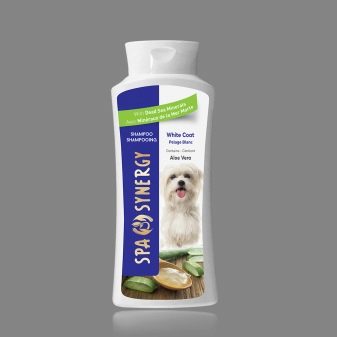
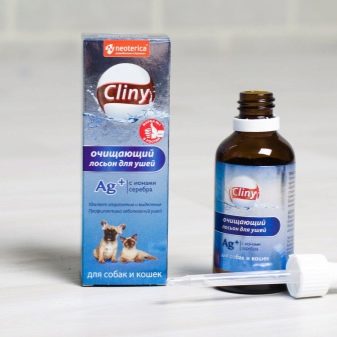
If you notice that purulent discharge is present at the corners of the eyes, then you should visit a veterinarian with your pet. You should not engage in self-treatment at home - entrust it to a professional. Eye drops should only be used as directed by a specialist.
The oral cavity of these dogs is their weakness and vulnerability. Since the teeth sit in the gums more tightly than in other cases, it is required to resort to a thorough but careful brushing weekly. To remove all soft plaque from the teeth, it is worth using a special zoo. Pastes with different flavors are especially popular for animals. Such a tool is applied to a toothbrush, and then all food debris is removed with it, making sweeping movements. In pet stores, you can also find very small attachments on the finger, with the help of which you can also easily and without unnecessary inconvenience brush the dog's teeth.
If you notice an unpleasant odor from your dog's mouth, this indicates that tartar has formed on your teeth. You should not fight it yourself. Contact a specialist who can relieve your pet of a similar problem.
The claws of novice terriers do not need special attention, but owners should still buy a special claw cutter. If your pet's claws do not have time to grind on hard surfaces, they should be carefully trimmed as they grow. Carrying out these procedures, it is very important not to accidentally damage the "live" half of the claw, where the blood vessels are located. Use a nail file to smooth out the sharp edges of the claws. It is also possible to remove burrs with it.
It is recommended to use tools with a low grit value, because they are more suitable for grinding.
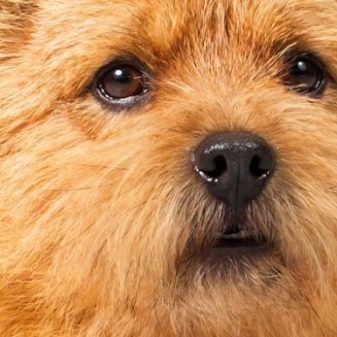
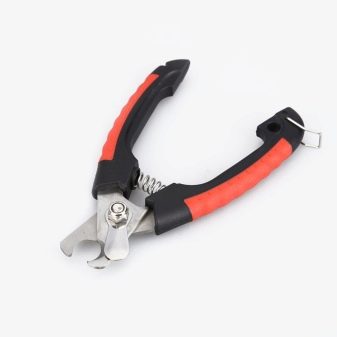
What to feed?
Norwich Terriers, like other well-known breeds, must eat healthy and suitable foods. These little hunters are not too demanding and capricious in their choice of food. They rarely suffer from food allergic reactions. Norwich is allowed to feed both ready-made industrial feed and high-quality natural products of the first freshness. The combination menu is not always suitable, because it can cause a number of problems associated with the digestive system of the animal. Experts advise against such feeding.
If you decide to feed a thoroughbred dog with ready-made food, then worth buying exclusively premium and super premium options... Holistic feed is perfect, in which there is a high content of vitamin complexes and minerals. Dry granulated food will help to clean the teeth of the animal, thereby avoiding the formation of tartar. Wet food is more suitable for young puppies or lactating bitches, as well as older individuals.
Many owners prefer to feed Norwich Terriers not with ready-made food, but with natural products. In this case, the basis of the diet should be meat. From the total amount of food, it should be at least 60%. Raw or boiled cuts of beef are ideal. A small layer of fat is allowed. The presence of tendons and cartilages is not prohibited. An excellent combination - meat and boiled sea fish. The latter should not be with bones.
Experts advise from time to time to dilute such a diet with offal, for example, a raw heart or cooked beef liver.
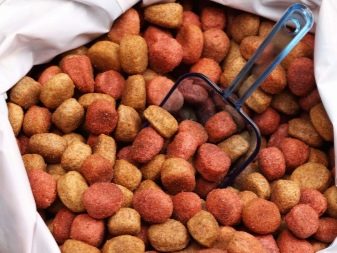
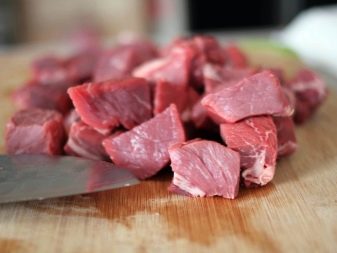
It is necessary to add various cereals to the diet of these pets. Cereals are allowed: buckwheat or rice. The latter can be diluted with finely chopped vegetables or even fruits. Eating vegetable oil every day will have a positive effect on the condition of the skin, claws, and Norwich wool. A serving should not exceed 1 tablespoon.
The diet of terriers should not contain:
- meat with a high percentage of fat (pork or lamb);
- products with a high carbon content;
- river fish (this product is prohibited in any form);
- products made from wheat flour;
- raw chicken;
- seeds with seeds;
- spicy foods;
- legumes;
- tubular bones;
- whole milk;
- muffins and sweets in any form.
There should always be fresh and clean water in the dog's bowl. It can be bottled or running, but infused for 6-8 hours.
It is not recommended to give boiled water to Norwich, because over time its use can provoke the development of urolithiasis.



Health and disease
Norwich Terriers are pets with excellent health and strong immunity. They are resistant to colds. If you keep such an animal in conditions suitable for it and feed it with quality food, you will not have to constantly visit a veterinarian with it.
Despite the fact that these dogs rarely get sick, nevertheless, there are some ailments that occur in such terriers more often than others... These include all sorts of pathologies related to the respiratory system, and such a serious disease as epilepsy. Some individuals of this breed suffer from brachycephalic syndrome.
The pledge of a pet's long life is timely vaccination. The first vaccination must be given when the puppy is 2 months old. A follow-up vaccination will be needed in 2 weeks.At 6 months old, a purebred Norwich is vaccinated against rabies.
At the same time, the complex vaccination of the pet against parainfluenza, plague and parvovirus is not forgotten.


How to educate?
In the "pack" Norwich can take a leading position, therefore, from the first days of its appearance in a new house, this pet needs to establish all the basic rules. First, you need to separate the territorial boundaries within which the animal can be. If it seems to you that the bedroom or nursery is not suitable for terrier visits, you need to make it clear to your pet that a closed door is an insurmountable obstacle, at which you need to stop and wait for your owner.
It is important to instill good manners in your dog. When you walk with your pet, immediately stop absolutely any "race" for pigeons or cats. Don't let your pet jump on strangers. Ideally, a Norwich shouldn't pay any attention to people passing by. Thus, it will be possible to avoid a huge number of conflict situations.
Do not interfere with your pet from communicating with its relatives. Early socialization is required for this breed. It is advisable for the Norwich Terrier to select more friendly and non-spiteful friends. Age and gender of pets do not play any role.
The intelligence level of these animals is high, so they are easy to train. Throughout the training program, the owner must follow the sequence and be patient. The doggie can begin to be stubborn, despite the fact that he wants to please "his" person.
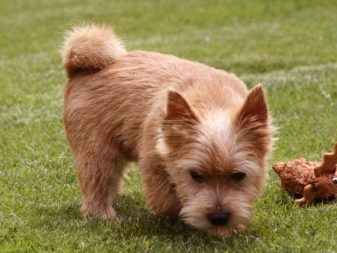
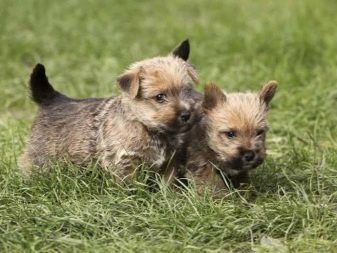
Arouse your pet's interest in new teams - then training will be simple, fast and fun. Motivate your little hunter with exceptional praise and delicious treats.
In the course of training and training the Norwich Terrier (it does not matter if it is a puppy or an adult dog), you must not be rude - shout or resort to physical punishment. This behavior of the owner will not end with anything good. As a result, the relationship with the dog will be ruined, and she will not treat the person as her friend and colleague.
The most common problem of the representatives of the described breed is the response to the call of the owner, if the pet is very carried away by something. A nickname is the last thing you can hope for: Terriers will simply not pay attention to it. It is advisable not to go far and for a long time from such a dog. You need to use a special tape measure, especially when you are in areas with heavy traffic.
Norwich are frequent participants in various competitions: freestyle, agility and other kinds of "dog" sports. If you want your dog to participate in these activities, you need to hire a professional trainer.
Regular training and good rewards for correctly executed commands will be the key to the success of the future four-legged champion.
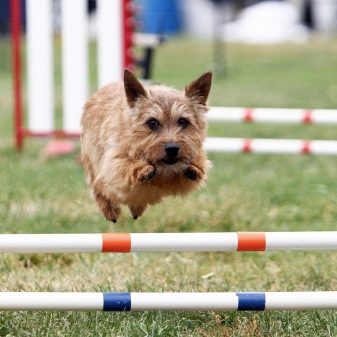
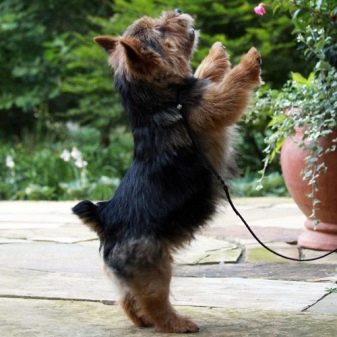
List of nicknames
The adorable Norwich Terrier has a wide variety of nicknames. The first step is to teach the puppy's name. Since it will have to be called many times throughout the day, it is better to give preference to the more understandable, shorter, easier pronunciation. When choosing a nickname for your beloved dog, you should pay attention to his appearance and character. These parameters will allow you to choose the most suitable name for your pet, which will suit him.
So, for girls of the Norwich breed, such interesting nicknames are ideal:
- Erika;
- Jesse;
- Wendy;
- Lucy;
- Taffy.
If you have a terrier boy, then you can choose a good name for him from the ones below:
- Alto;
- Rem;
- Gray;
- Chris;
- Jay.
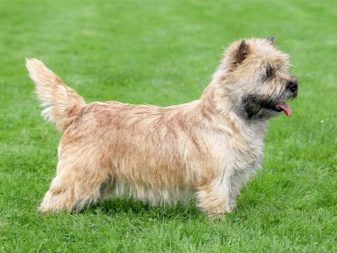
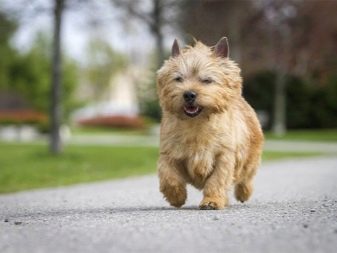
Helpful hints and tips
Keeping such a cute pet some advice and advice from experts should be considered.
- Norwich often exaggerate their importance, which is why they can enter into a fight with their larger and more powerful brothers. In such situations, only a professional dog handler will help or an extreme measure - castration of the male.
- It is recommended to walk Norwich in the company of burrowing terriers. These pets are used to biting each other's faces. Representatives of other breeds may misunderstand such gestures.
- Pork is a prohibited food for these dogs. And it's not just about its fat content. Such meat is completely indigestible in the body of Norwegians, therefore, such products should not be given to them under any circumstances.
- Pet nutrition should be monitored. Portions should not be too large, as Norwegians are prone to obesity, which leads to a host of other serious health problems.
- It is possible to train a Norwich Terrier puppy to the litter box. But this does not mean that after that the dog will not need to be walked.
- Norwich Terriers are not recommended to be kept in the same territory with small rodents or rabbits. Dogs can perceive such pets as an object for hunting.
- Norwich terriers are gaining more and more popularity, the color of the coat of which is black and back. If you are picking up such a pet, pay attention to its back: it will have a dark shade, and the belly and paws will be wheat or brown.
- In the dwelling for such a pet, you should highlight your own corner, where its cozy sleeping place, favorite toys, as well as bowls for food and water will be located.
- It is advisable to regularly visit a veterinarian with such a dog, despite its good immunity. Thus, you can bypass many possible ailments that your pet is at risk of encountering.
- The process of education and training should begin from the first days of the puppy's appearance in the new home. Do not waste time and do not postpone it for "later", because over time the dog will be less amenable to the educational process.
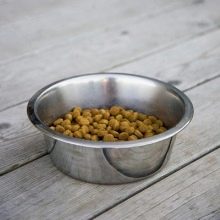
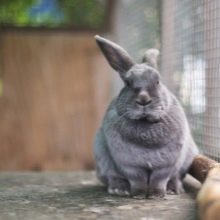
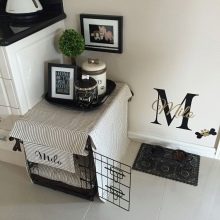
In the next video you will find interesting facts about the Norwich Terrier breed.






































